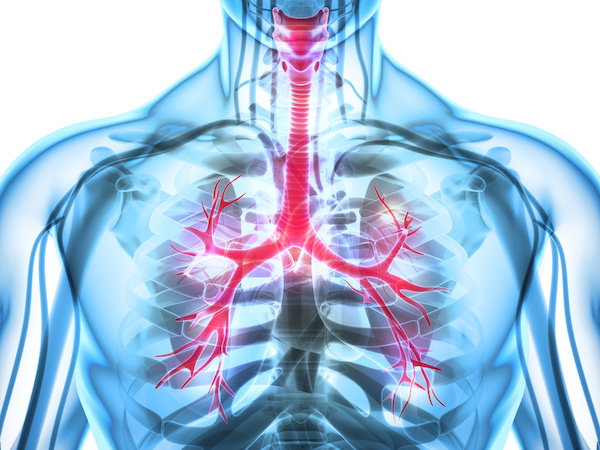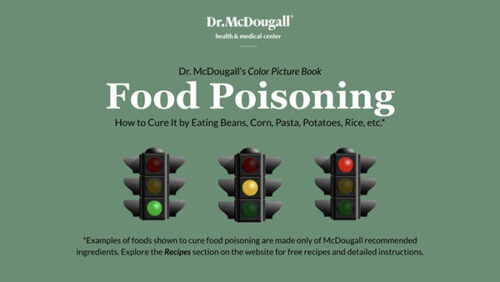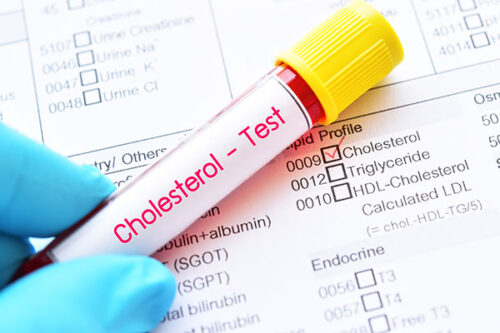Better Breathing from Diet

This article originally appeared in the May 2010 McDougall Newsletter and has been updated in February 2023.
By John McDougall, MD
Asthma medication sales are projected to be $ 34.3 billion in 2028 with an estimated 334 million people in Western societies suffering with breathing difficulties. Asthma is the active airway constriction (bronchospasm) component of a triad that makes up chronic obstructive pulmonary disease (COPD). Bronchitis is the inflammatory part of COPD and the end result of years of inflammation is emphysema (fibrosis or scarring).
Certainly, our atmosphere is becoming more polluted with irritating chemicals and particles. And, of course, the first actions to take are to clean up your air by stopping smoking, avoiding dirty air, and using air purifiers. The other factor you potentially have complete control over is your diet, which I believe is the main cause of the escalating epidemic of lung diseases we are now experiencing.
An unhealthy diet will increase a person’s susceptibility to known causes of lung disease, such as allergens, tobacco smoke, infectious agents, and air pollution. One of the best examples of the importance of diet and lung health is demonstrated by the low incidence of lung cancer among Japanese cigarette smokers. The risk of lung cancer in the United States is at least 10 times higher than in Japanese living in Japan despite the higher percentage of smokers among the Japanese.1 Smokers of Japanese descent living in the US have the same incidence of lung cancer as do the rest of Americans. These findings point to the importance of the differences in the diets followed in Japan and the US. The starch-based (rice and vegetable) diet followed by most Japanese smokers allows the body to defend and repair the damages from smoked tobacco far more effectively than does a diet of fat and protein (meat and dairy products); the American diet.
Many large population studies have shown that people who eat healthier diets, meaning more vegetables and fewer animal foods, have less lung disease.2-6 One study of 52,325 participants found that individuals whose diets are rich in meat reported new onset of persistent coughs with phlegm 43 percent more often than those who consume a diet high in fruit.2
How Diet Effects Lung Function
There are several important ways a healthier diet will help people, with and without COPD, breathe better. Fortunately, all of these mechanisms are tied together and answered by a low-fat starch-based diet, the McDougall diet, and some moderate exercise.
People Are Too Fat to Breathe
Obese women have a 50 percent higher rate of asthma compared to non-obese women.7 The reduction in lung function is largely due to the body fat that builds up inside the abdomen and pushes up against the main breathing muscle, the diaphragm, and thereby restricting the capacity of the lungs to expand. Lung function improves following weight loss in obese people.7 The best way to lose weight permanently is with the starch-based McDougall diet. Exercise also encourages weight loss. The benefits to lung function are from the lost weight, not the aerobic exercise.8
Acid Reflux Burns the Lungs
Complications from acid reflux, also known as gastrointestinal reflux disease (GERD), include asthma and COPD. When the acid from the stomach refluxes up into the mouth and is inhaled into the lungs, serious inflammation results. Inhaled into the bronchial (airway) tubes the acid burns the tissues, producing constriction, swelling, and mucus. Somewhere between 34 percent and 89 percent of asthmatics have GERD.9 Seventy-five percent of children with asthma have GERD.9 Patients with asthma caused by GERD commonly complain of heartburn, regurgitation, and difficulty swallowing. (But not always. Many people have important reflux with no symptoms.) Their asthma is worsened by meals and when lying down, or sleeping. Treatment with a healthy diet that reduces the chances of reflux, raising the head of the bed by four to six inches helps too, and as a last resort, antacids, will relieve asthma and many other breathing problems, and reduce the need for asthma medications.10
Pulmonary Circulation Is Impaired By Fats and Oils
Blood cells within the blood vessels flow freely and bounce off one another prior to a high-fat meal. Approximately one hour after a fatty meal, the cells begin to stick together upon contact and form clumps. As this clump formation progresses, the flow of blood slows. Six hours after the meal, the clumping becomes so severe that the blood flow actually stops in many small vessels. Several hours later the clumps break up and the blood flow returns to the tissues. As a result of these changes, the oxygen content of the blood decreases by 20 percent.11 The consequence of this impaired circulation can be angina, impaired brain function, high blood pressure, fatigue, as well as compromise of the function of the lungs.12
Please note that the circulation is as severely impaired by vegetable oils as it is with animal fats.13,14 Again the right approach to help the lungs function is to follow the low-fat McDougall diet.
Inflammation of Airways Caused By Diet
Although highly controversial, there has been much written about foods causing allergic reactions that lead to spasms of the airways, mucus production, and difficulty breathing. Over sixty years ago research suggested that a variety of foods could contribute to asthma and found that in asthma patients symptoms often improved with an exclusion diet.15
Just this month (May 2010) it was reported at the American Thoracic Society meeting in New Orleans that individuals with asthma who consumed a high-fat meal showed increased airway inflammation just hours after their binge. The high-fat meal also appeared to inhibit the response to their asthma medication, such as Ventolin (albuterol).16
Steps To Take for Better Breathing
Cleaning up the air around you by quitting smoking and using air purifiers is an obvious first step.
Next, switch to a diet based on starches with the addition of fruits and vegetables. This will immediately reduce gastrointestinal reflux and start you on a course of losing excess weight. There are some modifications to the basic diet that will additionally help to quiet the stomach. Cooked vegetables are much better tolerated than raw. Onions, green peppers, radishes, and cucumbers are notorious for causing indigestion, but when cooked many people no longer notice upset. Fruit juices (grapefruit, orange, etc.) frequently cause indigestion and contribute to reflux. The whole fruit is rarely troublesome. Many people need to avoid hot spices.
Raising the head of the bed by four to six inches with blocks (like a 4X4 or a brick) is an often overlooked, but highly effective, method of utilizing gravity to keep acid out of the throat and lungs, and in the stomach where it belongs. The final step to take to reduce acid reflux (GERD) is potent acid-suppressing agents called proton pump inhibitors, but these do have significant costs and side effects.
I believe dairy proteins are the most likely offenders when it comes to the allergic component of asthma, and egg proteins may be second. However, some plant foods may be troublesome too. People often talk about wheat and other grains, maybe corn, as mucous-forming. Keep a diary and try to notice foods that trouble you. The best, but most difficult, way to find offending foods is to follow the elimination diet. This diet is based on rice and sweet potatoes as the primary starches with the addition of non-citrus fruits and green and yellow vegetables. Everything is cooked thoroughly. Water is the beverage. Because of the extra restrictions, this is a very effective weight-loss diet too.
If you are having problems breathing do not overlook the cost-free, side-effect-free approach of a starch-based diet.
References:
1) Stellman SD, Takezaki T, Wang L, Chen Y, Citron ML, Djordjevic MV, Harlap S, Muscat JE, Neugut AI, Wynder EL, Ogawa H, Tajima K, Aoki K. Smoking and lung cancer risk in American and Japanese men: an international case-control study. Cancer Epidemiol Biomarkers Prev. 2001 Nov;10(11):1193-9.
2) Butler LM, Koh WP, Lee HP, Tseng M, Yu MC, London SJ; Singapore Chinese Health Study. Prospective study of dietary patterns and persistent cough with phlegm among Chinese Singaporeans. Am J Respir Crit Care Med. 2006 Feb 1;173(3):264-70.
3) Walda IC, Tabak C, Smit HA, R‰s‰nen L, Fidanza F, Menotti A, Nissinen A, Feskens EJ, Kromhout D. Diet and 20-year chronic obstructive pulmonary disease mortality in middle-aged men from three European countries. Eur J Clin Nutr. 2002 Jul;56(7):638-43.
4) Jiang R, Paik DC, Hankinson JL, Barr RG. Cured meat consumption, lung function, and chronic obstructive pulmonary disease among United States adults. Am J Respir Crit Care Med. 2007 Apr 15;175(8):798-804.
5) Varraso R, Jiang R, Barr RG, Willett WC, Camargo CA Jr. Prospective study of cured meats consumption and risk of chronic obstructive pulmonary disease in men. Am J Epidemiol. 2007 Dec 15;166(12):1438-45.
6) Varraso R, Willett WC, Camargo CA Jr. Prospective study of dietary fiber and risk of chronic obstructive pulmonary disease among US women and men. Am J Epidemiol. 2010 Apr 1;171(7):776-84.
7) Aaron SD, Fergusson D, Dent R, Chen Y, Vandemheen KL, Dales RE. Effect of weight reduction on respiratory function and airway reactivity in obese women. Chest. 2004 Jun;125(6):2046-52.
8) Womack CJ, Harris DL, Katzel LI, Hagberg JM, Bleecker ER, Goldberg AP. Weight loss, not aerobic exercise, improves pulmonary function in older obese men. J Gerontol A Biol Sci Med Sci. 2000 Aug;55(8):M453-7.
9) Simpson W. Gastroesophageal reflux disease and asthma. Diagnosis and management. Arch Intrn Med 155: 798-803, 1995.
10) Hogan W. Medical treatment of supraesophageal complications of gastroesophageal reflux disease. Am J Med. 2001 Dec 3;111 Suppl 8A:197S-201S.
11) Kuo P, Whereat AF, Horwitz O. The effect of lipemia upon coronary and peripheral arterial circulation in patients with essential hyperlipemia. Am J Med. 1959 Jan;26(1):68-75.
12) D. Hazlett. Dietary Fats Appear to Reduce Lung Function. JAMA. 1973; 223(1):15.
13) Friedman M, Rosenman RH, Byers SO. Serum lipids and conjunctival circulation after fat ingestion in men exhibiting type-A behavior patterns. Circulation. 1964 Jun;29:874-86.
14) Friedman M, Byers SO, Rosenman RH. Effect of unsaturated fats upon lipemia and conjunctival circula- tion. A study of coronary-prone (pattern A) men. JAMA. 1965 Sep 13;193:882-6.
15) Bartley J, McGlashan SR. Does milk increase mucus production? Med Hypotheses. 2010 Apr;74(4):732-4
16) http://www.eurekalert.org/pub_releases/2010-05/ats-hma051010.php
Recommended Articles

Alzheimer's Disease is Caused by Chronic Aluminum Poisoning

Dr. McDougall’s Color Picture Book: "Food Poisoning"






Join the Conversation!
Have a question, a helpful tip, or a story from your journey? Add it below - your voice matters.